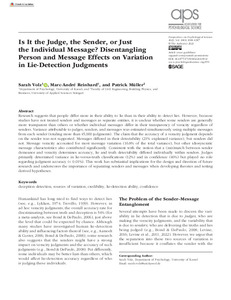| dc.date.accessioned | 2023-11-30T10:07:03Z | |
| dc.date.available | 2023-11-30T10:07:03Z | |
| dc.date.issued | 2023-02-15 | |
| dc.identifier | doi:10.17170/kobra-202311309123 | |
| dc.identifier.uri | http://hdl.handle.net/123456789/15239 | |
| dc.description.sponsorship | Gefördert im Rahmen des Projekts DEAL | ger |
| dc.language.iso | eng | |
| dc.rights | Namensnennung-Nicht-kommerziell 4.0 International | * |
| dc.rights.uri | http://creativecommons.org/licenses/by-nc/4.0/ | * |
| dc.subject | deception detection | eng |
| dc.subject | sources of variation | eng |
| dc.subject | credibility | eng |
| dc.subject | lie-detection ability | eng |
| dc.subject | confidence | eng |
| dc.subject.ddc | 150 | |
| dc.title | Is It the Judge, the Sender, or Just the Individual Message? Disentangling Person and Message Effects on Variation in Lie-Detection Judgments | eng |
| dc.type | Aufsatz | |
| dcterms.abstract | Research suggests that people differ more in their ability to lie than in their ability to detect lies. However, because studies have not treated senders and messages as separate entities, it is unclear whether some senders are generally more transparent than others or whether individual messages differ in their transparency of veracity regardless of senders. Variance attributable to judges, senders, and messages was estimated simultaneously using multiple messages from each sender (totaling more than 45,000 judgments). The claim that the accuracy of a veracity judgment depends on the sender was not supported. Messages differed in their detectability (21% explained variance), but senders did not. Message veracity accounted for most message variation (16.8% of the total variance), but other idiosyncratic message characteristics also contributed significantly. Consistent with the notion that a (mis)match between sender demeanor and veracity determines accuracy, lie and truth detectability differed individually within senders. Judges primarily determined variance in lie-versus-truth classifications (12%) and in confidence (46%) but played no role regarding judgment accuracy (< 0.01%). This work has substantial implications for the design and direction of future research and underscores the importance of separating senders and messages when developing theories and testing derived hypotheses. | eng |
| dcterms.accessRights | open access | |
| dcterms.creator | Volz, Sarah | |
| dcterms.creator | Reinhard, Marc-André | |
| dcterms.creator | Müller, Patrick | |
| dc.relation.doi | doi:10.1177/17456916221149943 | |
| dc.subject.swd | Lügendetektor | ger |
| dc.subject.swd | Glaubwürdigkeit | ger |
| dc.subject.swd | Vertrauen | ger |
| dc.type.version | publishedVersion | |
| dcterms.source.identifier | eissn:1745-6924 | |
| dcterms.source.issue | Issue 6 | |
| dcterms.source.journal | Perspectives on Psychological Science | eng |
| dcterms.source.pageinfo | 1368-1387 | |
| dcterms.source.volume | Volume 18 | |
| kup.iskup | false | |


